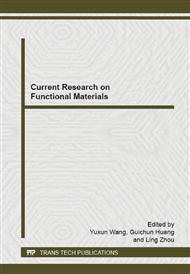p.177
p.181
p.185
p.193
p.201
p.208
p.216
p.224
p.231
Effect of Epoxy-Functionalization on the Halogen-Free Flame-Retardant Properties of Acrylonitrile-Butadiene-Styrene Resin
Abstract:
Epoxy-functionalized ABS-g-GMA powder was prepared with polybutadiene as core and styrene-co-acrylonitrile-co-glycidyl methacrylate as shell. The ABS-g-GMA powder, styrene-co-acrylonitrile copolymer (SAN) and triphenyl phosphate (TPP) was melt blended together and halogen-free flame-retardant ABS resin was prepared. The research found that when the content of TPP was 20wt%, the epoxy-functionalized ABS resin (eABS) showed much higher thermo-stability than the ordinary ABS resin. The burning rate of eABS decreased from 35mm/min to 8.6mm/min, mass loss rate decreased from 25%/min to 10%/min and limit oxygen index increased from 22% to 28%. FTIR showed that the chemical reactions took place between eABS and the decomposition products of TPP. The tensile tests and impact test found that the eABS/TPP samples showed higher elastic modulus, tensile strength and impact strength than ABS/TPP samples.
Info:
Periodical:
Pages:
201-207
Citation:
Online since:
October 2014
Authors:
Keywords:
Price:
Сopyright:
© 2014 Trans Tech Publications Ltd. All Rights Reserved
Share:
Citation:


